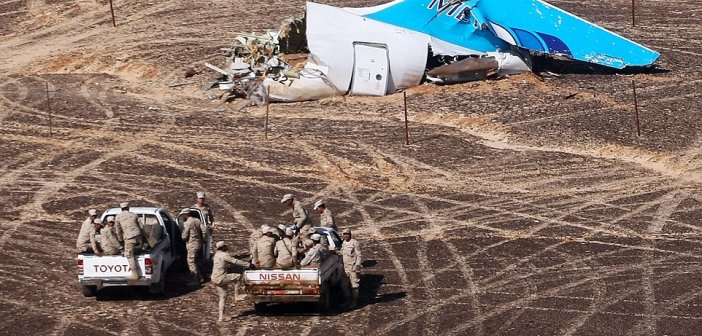Egyptian authorities have claimed that there is 'no proof' that a Russian Airbus which crashed in northern Sinai on Saturday broke up in mid air despite wreckage from the jet being spread over a 20 square mile radius.
Egypt’s civil aviation ministry said Russian officials were wrong to claim the jet broke up at high altitude.
Mohamed Rahmi said no distress call had been received from the jet, despite earlier claims by Egyptian authorities that the pilot had radioed and asked for an emergency landing.
Mr Rahmi said: 'No communication from the pilot was recorded at the navigation centres requesting anything.'
He added: 'This could be a long process and we can’t talk about the results as we go along.'
However, Egyptian authorities have interrogated catering staff who supplied food to the doomed jet on Saturday morning at Sharm el-Sheikh airport.
While Egyptian authorities attempt to deflect any possible terrorism link to the tragedy, Russian officials are keen to stress that the aircraft was in a safe condition to fly when it departed Sharm el-Sheikh on Saturday morning.
Russian crash investigators are satisfied that the Airbus A321 broke up at high altitude just 23-minutes after it left Sharm el-Sheikh on its way to St Petersburg with 224 passengers and crew on board.
Russian media outlet LifeNews claims that more than 200 fragments of human remains from approximately 150 people have arrived in St Petersburg.
According to sources, there was a significant difference in the cause of death between passengers at the front and the rear of the aircraft.
Those at the front suffered 'blunt force trauma of the chest, abdomen and pelvis with multiple fractures of upper and lower limbs with tears to the internal organs. Deaths occurred due to acute blood loss, shock and open head injuries.'
Those at the rear of aircraft suffered 'explosive trauma with multiple burns over 90 per cent of their soft tissues'.
Passengers at the back had shrapnel injuries and were peppered with metal particles.
The experts are trying to determine whether the blast injuries were caused by ruptured fuel tanks or an 'unidentified explosive device'.
Victims at the back also suffered injuries inflicted by a shockwave.
Egyptian authorities are interrogating the driver and staff of a catering company which supplied food to the aircraft on the morning of the aircraft.
The food trolleys are wheeled into the galley at the rear of the aircraft and stowed just in front of the rear pressure bulkhead.
Aviation sources have pointed to damage in the rear section of the plane which showed evidence of 'the fuselage skin peeling outwards possibly indicative of a force acting outwards from within' such as a bomb.
Investigators have also seized the the fuel truck used to refill the aircraft.
A spokesman for Misr Petroleum told Russian news agency Tass : 'The Misr Petroleum tank truck, which brought the kerosene to the plane, is currently at the airport, it is sealed.
'Experts from BP (British Petroleum) will take samples of aviation fuel to determine its quality and check it for the presence of likely impurities.
'Now a driver and employees who brought meals for the passengers of flight 9268 (Sharm el-Sheikh — St.Petersburg) in the morning on October 31 are being interrogated.'
On the ground Investigators have increased the search zone to some 20 square miles in an effort to recover vital evidence to help determine the cause of the disaster.
However, components not linked to the Airbus A321 have been found at the crash site while an initial examination of the CVR revealed 'unusual' sounds in the cockpit before the recording stopped.
TASS news agency in Moscow said: 'Experts have found elements in the crash zone that are not related to the plane's body.
'They have been sent for analysis.'
(dailymail.co.uk)
www.ann.az




